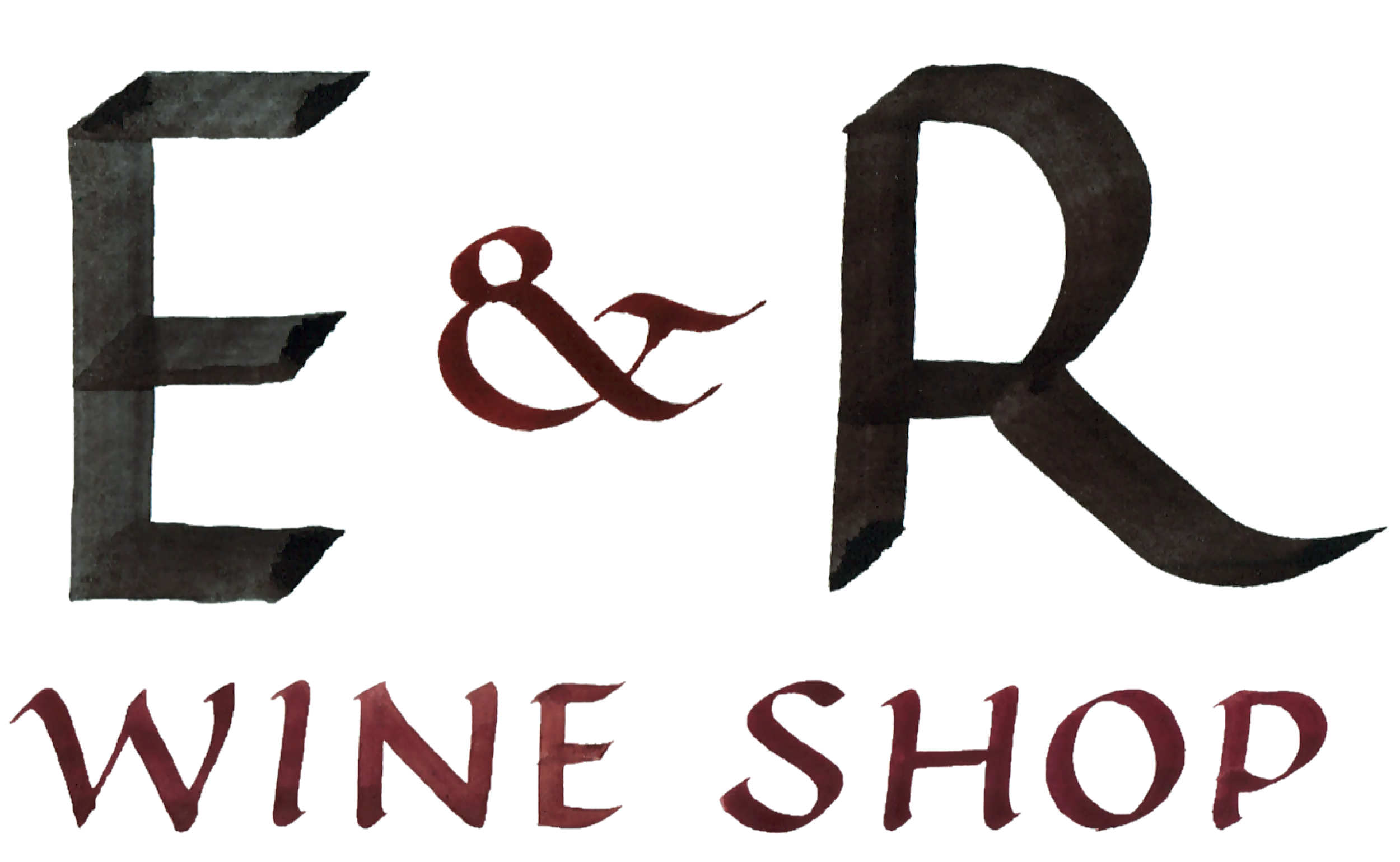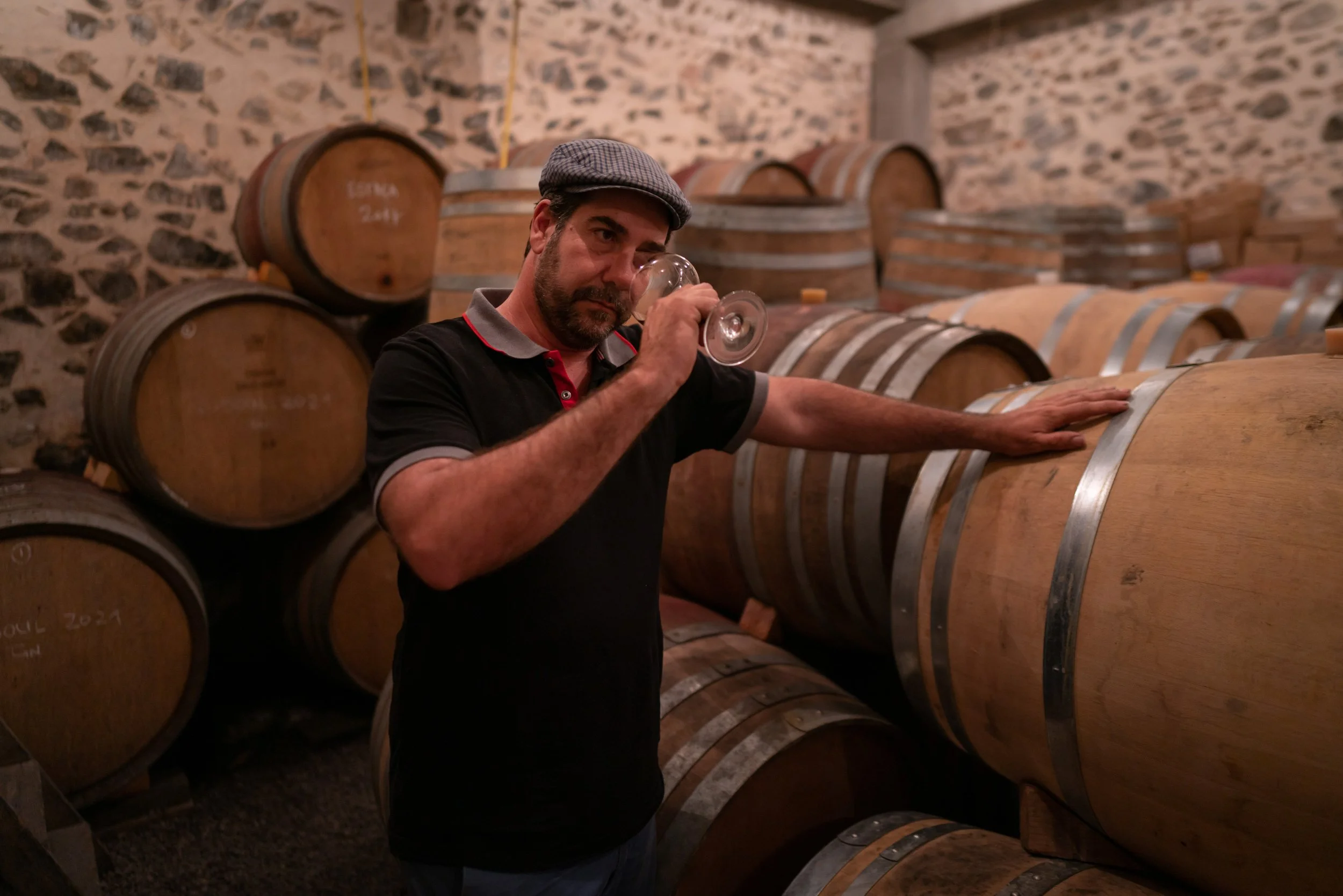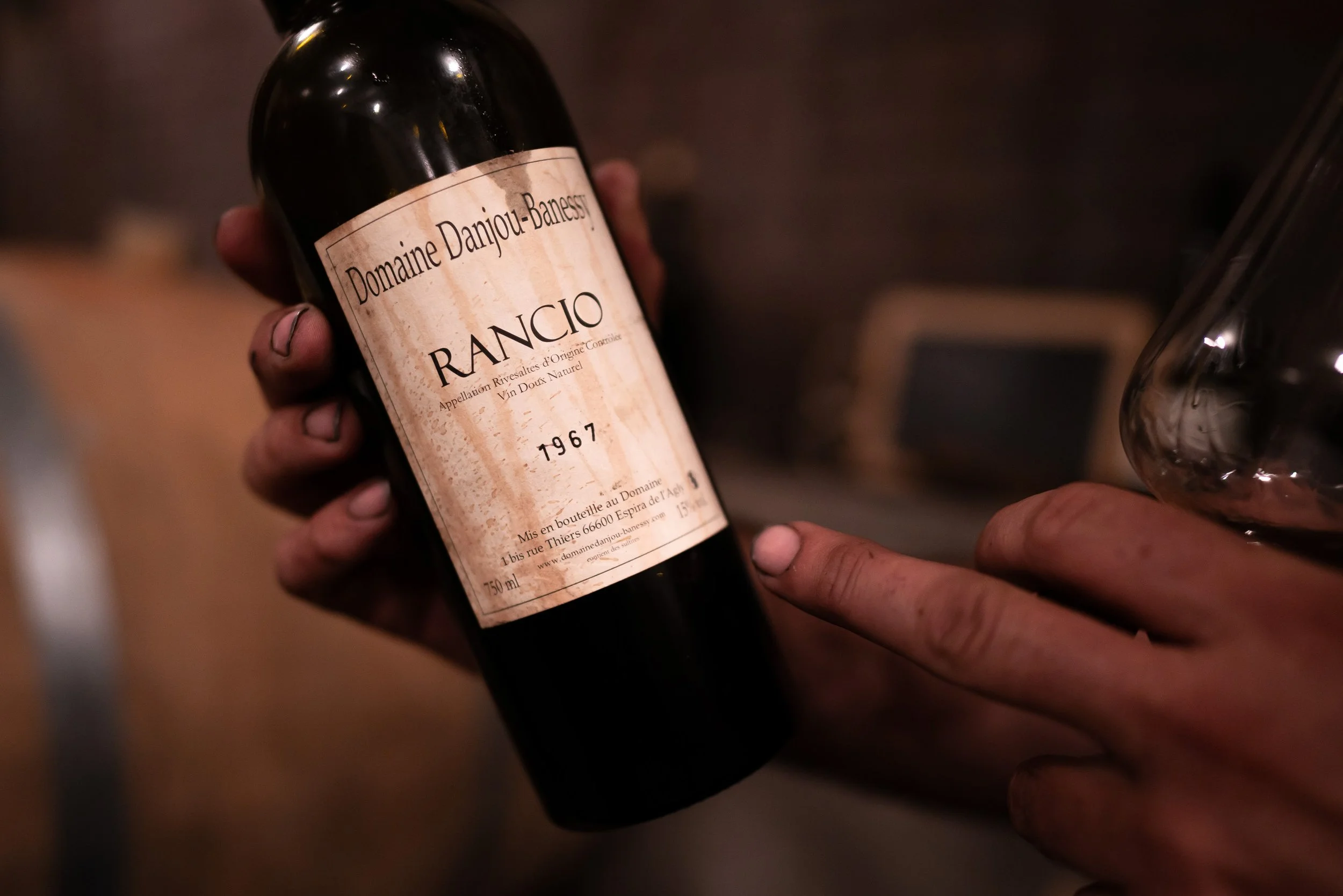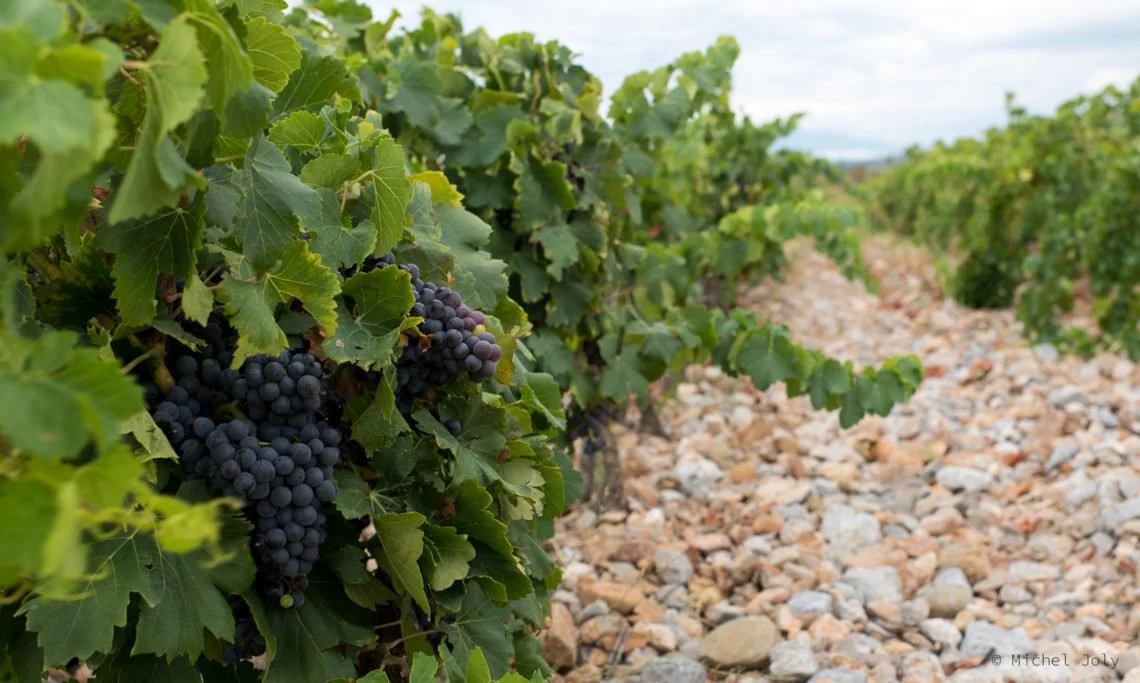Danjou-Bannessy - Espira-de-l'Agly, France
Sébastien Danjou in the cellars of the Domaine in Espira-de-l'Agly, France.
Photo by our Alex Fortson @ftnwcreative during our last visit to the Roussillon in May 2022.
Phoenicians planted vines near the shores of the mediterranean in 624 BC and some two dozen centuries later we are tasting something new….
The Danjou-Banessy estate is several centuries old but experienced an ongoing uptick in momentum and energy when brothers Sebastion and Benoit took over (officially) in 2001. According to their grandfather Denis, their family has been farming and making wine in the Roussillon “since forever”.
The Danjou-Banessy brothers are located in the village of Espira-de-L’Agly which sits in the Agly Valley within the Roussillon region of southern France. They currently farm 42 acres of organic red and white grapes with biodynamic principles between Roussillon and just to the west on the hills of Catalan as they themselves lean on the Pyrenees mountains.
100+ year old vines require tremendous support to stay upright and the vines here often face 100+ kph winds that make hedgerows and forestry management must have skills for viticulture.
Photo by our Alex Fortson @ftnwcreative during our last visit to the Roussillon in May 2022.
Like so many wineries in the Roussillon, the Danjou family and their winery were dedicated to the production of traditional fortified and sweet wines from neighboring appellations Rivesaltes. The trend in Roussillon over the last decade overwhelmingly favors dry wines as local winemakers are finding new potential with dry wines and the international market showing less interest in sweet wines and the Vin Doux Naturel wines of Roussillon’s various subregions like Maury, Banyuls and Muscat de Rivesaltes.
More recently, Roussillon has been making a reputation for itself as a region that produces rich, dense and structured reds in a way one might experience drinking wines from the Southern Rhone Valley just north (and a bit east) of Roussillon; there is a collage of terroirs and a similarity in the grapes used in both regions - Grenache, Mourvedre, Carignan and Cinsault are a few of the 24 “allowable” varietals.
No producer of wine has changed my perception and understanding of what the Roussillon region is capable of more than that of Danjou-Banessy. Their red wines show confidence and surety more than they do “power”. The reds have a core of compact fruit that is delicious and compelling but is just part of a nuanced, complex, mineral-driven profile. The whites are bound with energy and drive and have layers that unfold in the glass or over time in the bottle - these wines are truly an anomaly of freshness for warm climate whites acidity and a saline quality that speaks to their provenance.
There is a very unique and compelling collaboration of rusticity, transparency and elegance in these wines really make the Danjou-Banessy wines stand out among their peers in southern France.
Sébastien shares an older bottle of his grandfather’s ‘Rancio’, a fortified Vin Doux Naturel that was remarkable.
Photo by our Alex Fortson @ftnwcreative during our last visit to the Roussillon in May 2022.
CATALAN-ROUSSILLON
The formidable Pyrenees mountains form a geographical border between SW France and NE Spain; Le Canigou is the highest peak kissing the sky at some 9,000 feet. The growing seasons are long and warm in both Roussillon and Catalonia but Sebastian and Benoit seem to be in a favorable wine growing axis between the proximity to the mediterranean sea and the hills of Catalan. There is no region in France that sports a higher percentage of organic and biodynamic wines.
They are currently uprooting some of their old vines that have historically suffered wind damage and have been regenerating the fallow land with a rotation of cover crop that they sow. They are replanting many rows of fruit trees, almond, olive and native cypress trees to manage wind better. They are super into cover crop. They sow legumes, radishes, onions, herbs and various other plants. They till only between the vines and rarely. In winter they let a really sweet couple from Calce (Pithon also works with them) bring their sheep down to eat the grasses and herbs. The shepherds were set up communally with the help of the organic growers in the region. - Simon
Galetes roules, or round river rocks, that rule the plots where the brothers grow Maccabeu, Grenache and Mourvedre .
Some vinification methods that are threads through all of the wines listed below include no fining or filtering, no acidification or chaptalization and the fruit ferments spontaneously with native yeasts. All Danjou-Banessy wines are bottled according to the phases of the moon. All wines spend generous time aging in old wood barrels.
Sébastien tastes us through the current releases in the cellars of the domaine.
Photo by our Alex Fortson @ftnwcreative during our last visit to the Roussillon in May 2022.
2019 “Coste” Côtes Catalanes Blanc
100% Maccabeu fruit born on limestone and “galetes roules” (round river rocks) terroir which greatly informs this zippy and acid-driven juice. 10 months in barrel.
2019 “La Truffiere” Côtes Catalanes Blanc
100% Carignan Gris from 80+ year old vines digging into limestone bedrock and Schistone marl. Aged up to 20 months in Burgundian barrels.
2019 “Clos des Escounils” Côtes du Roussillon Blanc
A trio of Grenaches here: Blanc, Gris and Noir from some very senior vines on the other side of 100. 24 months in foudres.
2019 “Les Myrs” Côtes Catalanes Rouge
100% Carignan Noir fruit grown on 90+year old vines planted in the black shale of the certified organic Les Terres Noir vineyard in the northwest corner of their town. 20 months in barrel.
2018 “La Truffiere” Côtes Catalanes Rouge
Carignan Noir and Grenache Noir from the black slate Les Terres Noir vineyard with a vine age of 80 and 60 years old, respectively. 20 months in barrel.
2018 “Les Mirandes” Côtes Catalanes Rouge
“Les Mirandes” is made from 100% Syrah fruit grown on volcanic black basalt on the other side of the Agly valley and is the newest addition to the DB vineyard holdings. 15-22 months in barrel.
From Sebastian: "My grandfather was the last winemaker in the village to plant Syrah – obliged to do so because the appellation regulations demanded some Syrah in the cuvée (even though Syrah does not thrive in Roussillon). Because it was grown in the Rhône, it was considered ‘une cépage améliorateur’ – a superior grape to the local varieties. ‘These rigid, ignorant rules have resulted in the extinction of local varieties which could now be vitally important with climate change.’ We chose a black label for this cuvée alone for several reasons: the colour of the Syrah (so much deeper than all their other wines), the taste (‘very wild, sauvage, black’), and because it is not a Roussillon variety. This is an adoption."
2018 “Espurna” Côtes Catalanes Rouge
100% Cinsault from vines that have spent more than a century in the Les Terres Noir Vineyard. 30 months in barrel.
2018 “Estaca” Côtes du Roussillon Rouge
100% Grenache Noir from the Les Terres Noir vineyard and some of the oldest vines in sourthern France. This wine sees at least 24 months and up to 60 months (!) in barrel. This is the only wine that sees time in a new barrel, making up a whopping 3% of the vessels.
*A thank you to our friend Simon Lowry who is both a fan and representative for the Danjou-Banessy wines here in PDX for contributing photos and some notes from his recent trip to their winery and vineyards.





